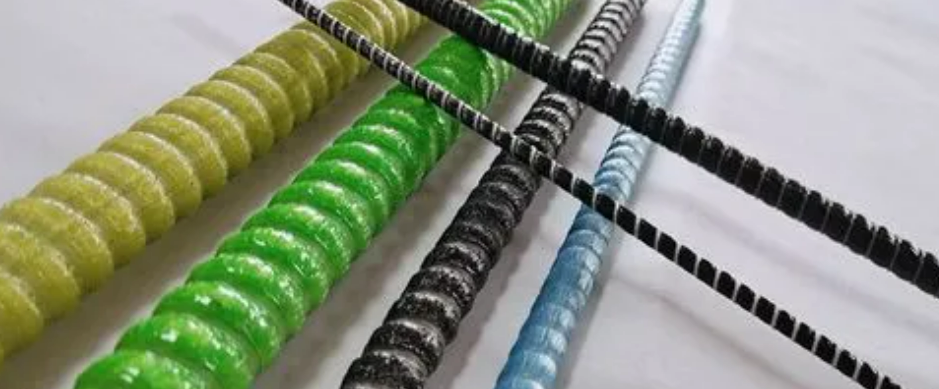Fiberglass reinforcement, also called GFRP reinforcement, is a new type of composite material. Many people are not sure what is the difference between it and ordinary steel reinforcement, and why should we use fiberglass reinforcement? The following article will introduce the advantages and disadvantages of fiberglass reinforcement and ordinary steel, and after the comparison, see if fiberglass reinforcement can replace ordinary steel?
What is fiberglass reinforcement material
As a new high-performance structural material, fiberglass reinforcement is widely used in subway tunnels (shield), highways, bridges, airports, docks, stations, water conservancy projects, underground projects and other fields, and can adapt to corrosive environments such as sewage treatment plants, chemical plants, electrolytic tanks, manhole covers, sea defense projects. Fiberglass reinforcement can solve many problems in engineering, make up for the shortcomings of traditional steel, and bring new development opportunities to civil and construction engineering.
The advantages and disadvantages of ordinary steel and fiberglass reinforcement
1, high load-bearing capacity, high tensile strength, the strength of the bar is twice as much as the same diameter rebar, but the weight is only 1/4 of the steel bar;
2、Stable elastic mode, about 1/3~2/5 of steel bar;
3、Electrical and thermal insulation, thermal expansion coefficient is closer to cement than steel;
4、good corrosion resistance, suitable for use in wet or other corrosive environments such as water conservancy, bridges, docks and tunnels;
5, shear strength is low, the ordinary fiberglass reinforcement shear strength is only 50 ~ 60MPa has excellent cutting properties.
In performance and steel basically similar, and concrete has good adhesion, but also has a high tensile strength and low shear strength, can be easily cut directly by the composite shield machine, without causing abnormal tool damage.
The difference between fiberglass reinforcement and steel reinforcement
1, in terms of construction time, compared to ordinary steel bars, fiberglass reinforcement is customized by the manufacturer, because the site can not be processed, so the size needs to be accurately controlled, once the wrong material will lead to delays in construction time. Its shape is directly customized, which reduces the processing steps of ordinary steel bars, and the lap method of tying replaces the welding process, saving the production time of the bar cage.
2、In terms of construction difficulty, the bending and shear resistance of fiberglass reinforcement is much different from that of ordinary steel bars and the quality is lighter, so it is less stable than ordinary steel cage in the process of cage lifting, cage lowering and pouring, easy to appear loose cage, cage jamming, floating and other special conditions, need special attention in cage making and lifting.
3、In terms of construction safety, compared with the construction method of partially or completely breaking the continuous wall of reinforcement cage at the shield end, the continuous wall of fiberglass cage can be directly penetrated by the shield machine, which avoids the dangerous conditions of mud, water and sand gushing, saves the cost of breaking the continuous wall, and also reduces the pollution of dust and noise.
4, in terms of economy, compared with ordinary steel, glass fiber reinforcement is lighter, which reduces the cost of the cage, and at the same time, because of the larger glass fiber cage, it reduces the width of the diaphragm wall, saves the number of diaphragm wall interface I-beam or locking pipe, and saves the cost.
Features of fiberglass reinforcement
1, high tensile strength: the tensile strength of fiberglass reinforcement is better than ordinary steel, higher than 20% of the same specification steel, and good fatigue resistance.
2, light weight: the mass of fiberglass reinforcement is only 1/4 of the same volume of steel, and the density is between 1.5 and 1.9 (g/cm3).
3, strong corrosion resistance: resistance to acid and alkali and other chemicals can resist the erosion of chloride ions and low pH solutions, especially the corrosion of carbon compounds and chlorine compounds stronger.
4、Strong material bonding: the coefficient of thermal expansion of fiberglass reinforcement is closer to cement than steel, because fiberglass reinforcement is stronger than concrete bonding grip.
5, strong designability: the elastic modulus of fiberglass reinforcement is stable, the size is stable under thermal stress, bending and other shapes can be arbitrarily thermoformed, good safety performance, non-thermal conductivity, non-conductive, flame retardant anti-static, through the formula change and metal collision will not produce sparks.
6, strong permeability to magnetic waves: fiberglass reinforcement is a non-magnetic material, in the non-magnetic or electromagnetic concrete members do not need to do demagnetization treatment.
7, convenient construction: fiberglass reinforcement can be produced according to user requirements for a variety of different cross-sections and lengths of standard and non-standard parts, on-site tying available non-metallic tensioning tape, simple operation.
The above is the introduction of the advantages and disadvantages of fiberglass reinforcement and ordinary steel, fiberglass reinforcement as a new high-performance structural materials, widely used in subway tunnels (shield), highways, bridges, airports, docks, stations, water conservancy projects, underground engineering and other fields, can adapt to sewage treatment plants, chemical plants, electrolytic tanks, manhole covers, sea defense projects and other corrosive environments.
Post time: Jan-29-2023







